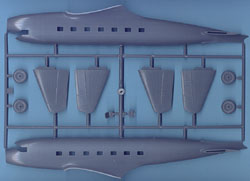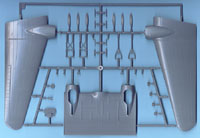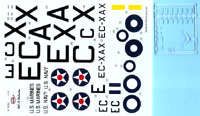History The rapid airline growth during the late 1920s and early 1930s led many manufacturers to come up with new designs quickly to meet the demands of airlines. In 1932 TWA issued a requirement for a new twin-engined transport. Douglas answered the call with the DC-2, of which TWA ordered 20. From there other airlines bought the DC-2, including KLM, Swissair and CSL (later CSA). Airlines weren't the only user of the DC-2, though. The USAAF received several, as did the US Navy and Marine Corps. Former civil DC-2s found their way into Spain during the Spanish Civil War, and some even ended up flying in the Australian Air Force and Finnish Air Force. The DC-2 wasn't the end of the run for Douglas twins, though, and we owe it to American Airlines for the much more famous DC-3. American wasn't happy with the capacity of the DC-2 and wanted a wider fuselage. This redesigned plane resulted in the DC-3, eventually overshadowing its smaller DC-2 brother. Even though the DC-3 was more popular, the DC-2 proved to be a sturdy workhorse and soldiered on for many years after the Second World War.  The Kit The Kit Who would have thought that we would see an injection-molded kit of the DC-2? I sure didn't, but here it is! This is one of MPM's new long-run technology kits and boy is it a good one. Very crisp moldings, no flash and fine detailing throughout mark this kit as a good start for their new process. Everything is molded in a dark gray plastic, with a small tree of nicely molded clear parts. There is no etched brass or resin in this kit, which for some might seem bad, but in the long run it keeps the price down (NKR out of Australia is listing it for around $22). Looking at the interior parts, you get a decent cockpit with a pair of seats, an instrument panel, a pair of control yokes, and a bulkhead. The cabin area is Spartan in comparison, consisting of just a floor and two bulkheads. Since all of the marking choices in this kit are for cargo birds, this is adequate, but for those of you wanting to do an airliner, you'll probably have to rob a DC-3 kit for seats. The windows along the sides are all individual rather than in a strip, so you'll want to take care in putting them in place. In fact, you might want to think about masking them before gluing them in place. Trimming masking tape with the windows off will be much easier than  trying to do the same after they're in place. trying to do the same after they're in place. The wings are broken down into five pieces, with a one-piece lower center section incorporating part of the lower fuselage. The upper wings are in one piece, right and left, with the lower outer panels finishing up the wings. This arrangement provides excellent strength and with the one-piece upper wing halves you are assured of the proper dihedral in the outer panels. The engine nacelles have an insert for the main gear roof, but there is no other detailing present. Two styles of vertical fins are included, but the instructions have you discard one. There is also two styles of noses, one with lights and one without. Again, the instructions tell you to discard the one without the lights (obviously planning a different version down the road).  Back to the engines, you are given just the engine fronts on a disc rather than a full engine. Around these go a pair of very nicely done one-piece nacelles. After struggling with two-piece cowlings in other MPM releases these are very welcome indeed. The propellers are in four pieces, with three separate blades and a separate hub. With the high quality of injection in this kit there won't be as many problems as there could have been, but you still will probably want to set up a jig to get the blades set right. Or maybe just rob that DC-3 kit again. Back to the engines, you are given just the engine fronts on a disc rather than a full engine. Around these go a pair of very nicely done one-piece nacelles. After struggling with two-piece cowlings in other MPM releases these are very welcome indeed. The propellers are in four pieces, with three separate blades and a separate hub. With the high quality of injection in this kit there won't be as many problems as there could have been, but you still will probably want to set up a jig to get the blades set right. Or maybe just rob that DC-3 kit again.
The decals offer a very interesting mix of markings for the DC-2. Like I mentioned previously, there are no civilian operators on the sheet (a disappointment to many, but rumor has it that there are some civilian markings coming from at least one aftermarket decal company). If silver is your game, you get two choices in this kit, both very similar. One is a US Navy DC-2 (R2D-1) and the other is a US Marine Corps one. Finish is identical on both of these, being overall silver with stars on the wings and a serial on the tail. The other two choices are for the boxtop DC-2 of the  RAAF and a Spanish Civil War DC-2. The RAAF one is as seen on the boxtop, in a two-tone camouflage. The Spanish Civil War DC-2 is finished in overall sand with green mottling and pale blue undersides. All of the choices are interesting and the decals are well printed and in excellent register. RAAF and a Spanish Civil War DC-2. The RAAF one is as seen on the boxtop, in a two-tone camouflage. The Spanish Civil War DC-2 is finished in overall sand with green mottling and pale blue undersides. All of the choices are interesting and the decals are well printed and in excellent register. Conclusion This is a very nice kit to see and whether your interest is in military or civil subjects you should definitely check this one out. Sitting next to a DC-3 model is a natural for this kit and will clearly show off the heritage of that famous twin. Now if someone would just come out with an injection DC-4/C-54, you could model the entire piston-engined Douglas airliners in 1/72. | 


 



  
    |

 The Kit
The Kit trying to do the same after they're in place.
trying to do the same after they're in place. Back to the engines, you are given just the engine fronts on a disc rather than a full engine. Around these go a pair of very nicely done one-piece nacelles. After struggling with two-piece cowlings in other MPM releases these are very welcome indeed. The propellers are in four pieces, with three separate blades and a separate hub. With the high quality of injection in this kit there won't be as many problems as there could have been, but you still will probably want to set up a jig to get the blades set right. Or maybe just rob that DC-3 kit again.
Back to the engines, you are given just the engine fronts on a disc rather than a full engine. Around these go a pair of very nicely done one-piece nacelles. After struggling with two-piece cowlings in other MPM releases these are very welcome indeed. The propellers are in four pieces, with three separate blades and a separate hub. With the high quality of injection in this kit there won't be as many problems as there could have been, but you still will probably want to set up a jig to get the blades set right. Or maybe just rob that DC-3 kit again. RAAF and a Spanish Civil War DC-2. The RAAF one is as seen on the boxtop, in a two-tone camouflage. The Spanish Civil War DC-2 is finished in overall sand with green mottling and pale blue undersides. All of the choices are interesting and the decals are well printed and in excellent register.
RAAF and a Spanish Civil War DC-2. The RAAF one is as seen on the boxtop, in a two-tone camouflage. The Spanish Civil War DC-2 is finished in overall sand with green mottling and pale blue undersides. All of the choices are interesting and the decals are well printed and in excellent register.






